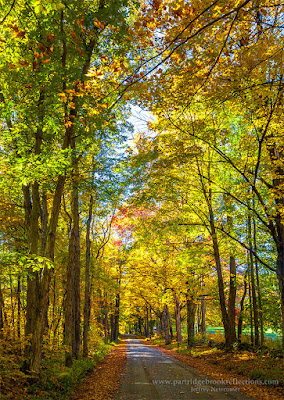Trapped by the Foliage Tour
 Last weekend I participated in the Monadnock regions Fall Foliage Art Studio Tour. During Saturday and Sunday I hosted visitors to my home in Spofford and displayed over 30 of my pictures spread through the downstairs. It was gratifying to show-off my work to an appreciative crowd. I especially enjoyed meeting several Facebook fans, but the weather was perfect and the color nearing peak, and as a photographer I was jumping out of my skin to get out and shoot the amazing foliage. At 5pm each day, I catapulted out of the door to catch the last glimmers of evening light, but the last few minutes of the golden hour were scant compensation for missing most of what may be two of the best shooting days of the year.
Last weekend I participated in the Monadnock regions Fall Foliage Art Studio Tour. During Saturday and Sunday I hosted visitors to my home in Spofford and displayed over 30 of my pictures spread through the downstairs. It was gratifying to show-off my work to an appreciative crowd. I especially enjoyed meeting several Facebook fans, but the weather was perfect and the color nearing peak, and as a photographer I was jumping out of my skin to get out and shoot the amazing foliage. At 5pm each day, I catapulted out of the door to catch the last glimmers of evening light, but the last few minutes of the golden hour were scant compensation for missing most of what may be two of the best shooting days of the year. But enough grumbling. Showing the work is an essential part of the deal, arguably as important as shooting the work. Happily, on Monday, the colors were still building, the air was crisp and clear and I got out several times to grab the season's bounty.

One Day of Autumn Glory
 |
| Surry Pasture |
This article is a chance to share the images from just one day of shouting in our most spectacular time of year. Monday was generally sunny, which provided its own challenges of shadows and reflections, but the colors showed to perfection especially when trans-illuminated and my polarizing filtered helped the rich hues shine through the reflected sunlight. I got some nice shots, and, in the process, I was reminded about how my shooting technique has evolved in recent time. Specifically how I have been expanding focus stacking to capture extreme depth of field.
 |
| Barn at the Bend |
Capturing Depth of Field
 |
| Md. Sherri Pond |
 |
| Slipping Arches, Md. Sherri Castle |
 |
| Bradley Hill Autumn |
The opportunities provided by Auto-Blending have led me to routinely bracket the focus on most of my images. On this one day of autumn shooting I returned with 240 images. Reviewing the collection I found that with all these images I captured only 45 different scenes, meaning that I took an average of just over five pictures per scene. This was almost entirely due to focus stacking.
Focus Stacking Gone Wild
 |
| Blended & Correction Layers |
As an extreme example, in the picture of the ferns along Gulf Brook, I blended seven images to get sharpness from foreground to background. I used my usual technique. I edited the images together in Lightroom and then used the "Open as layers in Photoshop" option to bring them into a single file. After aligning the layers I copied them into a separate stack that I could use to correct errors in the blended result. I then ran the original stack through Photoshop's magic Auto-Blend tool. The more recent versions of Photshop finish
 |
| DOF |

Monday was a great start on this year's local foliage season. There is no better time to revel in the glorious depth of color of New England. The images are piling up on my hard drives and I have lots of work to do. Thank goodness I have November coming on to allow me to catch up.

Jeffrey Newcomer
Partridgebrookreflections.com


Nice article Jeff. I can feel your pain of itching to get out when the colors are exploding.
ReplyDelete